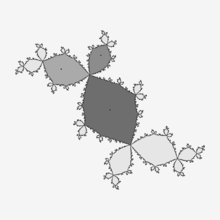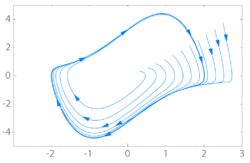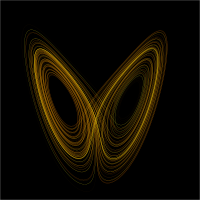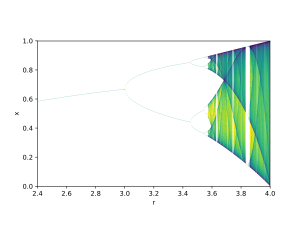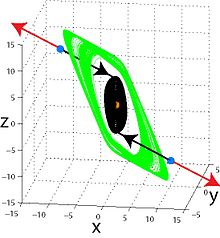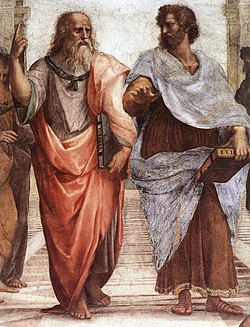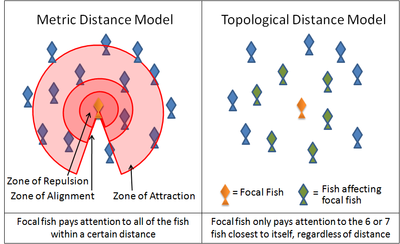Visual representation of a strange attractor
In the mathematical field of dynamical systems, an attractor is a set of numerical values toward which a system tends to evolve, for a wide variety of starting conditions of the system. System values that get close enough to the attractor values remain close even if slightly disturbed.
In finite-dimensional systems, the evolving variable may be represented algebraically as an n-dimensional vector. The attractor is a region in n-dimensional space. In physical systems, the n dimensions may be, for example, two or three positional coordinates for each of one or more physical entities; in economic systems, they may be separate variables such as the inflation rate and the unemployment rate.
If the evolving variable is two- or three-dimensional, the attractor of the dynamic process can be represented geometrically in two or three dimensions, (as for example in the three-dimensional case depicted to the right). An attractor can be a point, a finite set of points, a curve, a manifold, or even a complicated set with a fractal structure known as a strange attractor (see strange attractor below). If the variable is a scalar,
the attractor is a subset of the real number line. Describing the
attractors of chaotic dynamical systems has been one of the achievements
of chaos theory.
A trajectory
of the dynamical system in the attractor does not have to satisfy any
special constraints except for remaining on the attractor, forward in
time. The trajectory may be periodic or chaotic.
If a set of points is periodic or chaotic, but the flow in the
neighborhood is away from the set, the set is not an attractor, but
instead is called a repeller (or repellor).
Motivation of attractors
A dynamical system is generally described by one or more differential or difference equations.
The equations of a given dynamical system specify its behavior over any
given short period of time. To determine the system's behavior for a
longer period, it is often necessary to integrate the equations, either through analytical means or through iteration, often with the aid of computers.
Dynamical systems in the physical world tend to arise from dissipative systems: if it were not for some driving force, the motion would cease. (Dissipation may come from internal friction, thermodynamic losses,
or loss of material, among many causes.) The dissipation and the
driving force tend to balance, killing off initial transients and
settle the system into its typical behavior. The subset of the phase space of the dynamical system corresponding to the typical behavior is the attractor, also known as the attracting section or attractee.
Invariant sets and limit sets are similar to the attractor concept. An invariant set is a set that evolves to itself under the dynamics. Attractors may contain invariant sets. A limit set
is a set of points such that there exists some initial state that ends
up arbitrarily close to the limit set (i.e. to each point of the set) as
time goes to infinity. Attractors are limit sets, but not all limit
sets are attractors: It is possible to have some points of a system
converge to a limit set, but different points when perturbed slightly
off the limit set may get knocked off and never return to the vicinity
of the limit set.
For example, the damped pendulum has two invariant points: the point x0 of minimum height and the point x1 of maximum height. The point x0 is also a limit set, as trajectories converge to it; the point x1 is not a limit set. Because of the dissipation due to air resistance, the point x0 is also an attractor. If there was no dissipation, x0
would not be an attractor. Aristotle believed that objects moved only
as long as they were pushed, which is an early formulation of a
dissipative attractor.
Exponential divergence of trajectories complicates detailed predictions, but the world is knowable due to the existence of robust attractors.
Mathematical definition
Let t represent time and let f(t, •) be a function which specifies the dynamics of the system. That is, if a is a point in an n-dimensional phase space, representing the initial state of the system, then f(0, a) = a and, for a positive value of t, f(t, a) is the result of the evolution of this state after t
units of time. For example, if the system describes the evolution of a
free particle in one dimension then the phase space is the plane R2 with coordinates (x,v), where x is the position of the particle, v is its velocity, a = (x,v), and the evolution is given by
Attracting period-3 cycle and its immediate basin of attraction for a certain parametrization of f(z) = z2 + c.
The three darkest points are the points of the 3-cycle, which lead to
each other in sequence, and iteration from any point in the basin of
attraction leads to (usually asymptotic) convergence to this sequence of
three points.
An attractor is a subset A of the phase space characterized by the following three conditions:
- A is forward invariant under f: if a is an element of A then so is f(t,a), for all t > 0.
- There exists a neighborhood of A, called the basin of attraction for A and denoted B(A), which consists of all points b that "enter A in the limit t → ∞". More formally, B(A) is the set of all points b in the phase space with the following property:
-
- For any open neighborhood N of A, there is a positive constant T such that f(t,b) ∈ N for all real t > T.
- There is no proper (non-empty) subset of A having the first two properties.
Since the basin of attraction contains an open set containing A, every point that is sufficiently close to A is attracted to A. The definition of an attractor uses a metric on the phase space, but the resulting notion usually depends only on the topology of the phase space. In the case of Rn, the Euclidean norm is typically used.
Many other definitions of attractor occur in the literature. For example, some authors require that an attractor have positive measure (preventing a point from being an attractor), others relax the requirement that B(A) be a neighborhood.
Types of attractors
Attractors are portions or subsets of the phase space of a dynamical system. Until the 1960s, attractors were thought of as being simple geometric subsets of the phase space, like points, lines, surfaces, and simple regions of three-dimensional space. More complex attractors that cannot be categorized as simple geometric subsets, such as topologically wild sets, were known of at the time but were thought to be fragile anomalies. Stephen Smale was able to show that his horseshoe map was robust and that its attractor had the structure of a Cantor set.
Two simple attractors are a fixed point and the limit cycle.
Attractors can take on many other geometric shapes (phase space
subsets). But when these sets (or the motions within them) cannot be
easily described as simple combinations (e.g. intersection and union) of fundamental geometric objects (e.g. lines, surfaces, spheres, toroids, manifolds), then the attractor is called a strange attractor.
Fixed point
Weakly attracting fixed point for a complex number evolving according to a complex quadratic polynomial.
The phase space is the horizontal complex plane; the vertical axis
measures the frequency with which points in the complex plane are
visited. The point in the complex plane directly below the peak
frequency is the fixed point attractor.
A fixed point of a function or transformation is a point that is mapped to itself by the function or transformation.
If we regard the evolution of a dynamical system as a series of
transformations, then there may or may not be a point which remains
fixed under each transformation. The final state that a dynamical
system evolves towards corresponds to an attracting fixed point of the
evolution function for that system, such as the center bottom position
of a damped pendulum,
the level and flat water line of sloshing water in a glass, or the
bottom center of a bowl contain a rolling marble. But the fixed point(s)
of a dynamic system is not necessarily an attractor of the system. For
example, if the bowl containing a rolling marble was inverted and the
marble was balanced on top of the bowl, the center bottom (now top) of
the bowl is a fixed state, but not an attractor. This is equivalent to
the difference between stable and unstable equilibria.
In the case of a marble on top of an inverted bowl (a hill), that point
at the top of the bowl (hill) is a fixed point (equilibrium), but not
an attractor (stable equilibrium).
In addition, physical dynamic systems with at least one fixed
point invariably have multiple fixed points and attractors due to the
reality of dynamics in the physical world, including the nonlinear dynamics of stiction, friction, surface roughness, deformation (both elastic and plasticity), and even quantum mechanics. In the case of a marble on top of an inverted bowl, even if the bowl seems perfectly hemispherical, and the marble's spherical shape, are both much more complex surfaces when examined under a microscope, and their shapes change or deform
during contact. Any physical surface can be seen to have a rough
terrain of multiple peaks, valleys, saddle points, ridges, ravines, and
plains.
There are many points in this surface terrain (and the dynamic system
of a similarly rough marble rolling around on this microscopic terrain)
that are considered stationary or fixed points, some of which are categorized as attractors.
Finite number of points
In a discrete-time
system, an attractor can take the form of a finite number of points
that are visited in sequence. Each of these points is called a periodic point. This is illustrated by the logistic map, which depending on its specific parameter value can have an attractor consisting of 2n points, 3×2n points, etc., for any value of n.
Limit cycle
A limit cycle is a periodic orbit of a continuous dynamical system that is isolated. Examples include the swings of a pendulum clock,
and the heartbeat while resting. (The limit cycle of an ideal pendulum
is not an example of a limit cycle attractor because its orbits are not
isolated: in the phase space of the ideal pendulum, near any point of a
periodic orbit there is another point that belongs to a different
periodic orbit, so the former orbit is not attracting).
Van der Pol phase portrait: an attracting limit cycle
Limit torus
There
may be more than one frequency in the periodic trajectory of the system
through the state of a limit cycle. For example, in physics, one
frequency may dictate the rate at which a planet orbits a star while a
second frequency describes the oscillations in the distance between the
two bodies. If two of these frequencies form an irrational fraction (i.e. they are incommensurate), the trajectory is no longer closed, and the limit cycle becomes a limit torus. This kind of attractor is called an Nt-torus if there are Nt incommensurate frequencies. For example, here is a 2-torus:
A time series corresponding to this attractor is a quasiperiodic series: A discretely sampled sum of Nt periodic functions (not necessarily sine waves) with incommensurate frequencies. Such a time series does not have a strict periodicity, but its power spectrum still consists only of sharp lines.
Strange attractor
A plot of Lorenz's strange attractor for values ρ = 28, σ = 10, β = 8/3
An attractor is called strange if it has a fractal structure. This is often the case when the dynamics on it are chaotic, but strange nonchaotic attractors also exist. If a strange attractor is chaotic, exhibiting sensitive dependence on initial conditions,
then any two arbitrarily close alternative initial points on the
attractor, after any of various numbers of iterations, will lead to
points that are arbitrarily far apart (subject to the confines of the
attractor), and after any of various other numbers of iterations will
lead to points that are arbitrarily close together. Thus a dynamic
system with a chaotic attractor is locally unstable yet globally stable:
once some sequences have entered the attractor, nearby points diverge
from one another but never depart from the attractor.
The term strange attractor was coined by David Ruelle and Floris Takens to describe the attractor resulting from a series of bifurcations of a system describing fluid flow. Strange attractors are often differentiable in a few directions, but some are like a Cantor dust,
and therefore not differentiable. Strange attractors may also be found
in the presence of noise, where they may be shown to support invariant
random probability measures of Sinai–Ruelle–Bowen type.
Examples of strange attractors include the double-scroll attractor, Hénon attractor, Rössler attractor, Tamari attractor, and the Lorenz attractor.
Effect of parameters on the attractor
Bifurcation diagram of the logistic map. The attractor for any value of the parameter r is shown on the vertical line at that r.
A particular functional form of a dynamic equation can have various
types of attractor depending on the particular parameter values used in
the function. An example is the well-studied logistic map, whose basins of attraction for various values of the parameter r
are shown in the diagram. At some values of the parameter the attractor
is a single point, at others it is two points that are visited in turn,
at others it is 2n points or k × 2n points that are visited in turn, for any value of n depending on the value of the parameter r, and at other values of r an infinitude of points are visited.
Basins of attraction
An attractor's basin of attraction is the region of the phase space, over which iterations are defined, such that any point (any initial condition) in that region will eventually be iterated into the attractor. For a stable linear system, every point in the phase space is in the basin of attraction. However, in nonlinear systems, some points may map directly or asymptotically
to infinity, while other points may lie in a different basin of
attraction and map asymptotically into a different attractor; other
initial conditions may be in or map directly into a non-attracting point
or cycle.
Linear equation or system
A single-variable (univariate) linear difference equation of the homogeneous form diverges to infinity if |a| > 1 from all initial points except 0; there is no attractor and therefore no basin of attraction. But if |a|
< 1 all points on the number line map asymptotically (or directly in
the case of 0) to 0; 0 is the attractor, and the entire number line is
the basin of attraction.
Likewise, a linear matrix difference equation in a dynamic vector X, of the homogeneous form in terms of square matrix A will have all elements of the dynamic vector diverge to infinity if the largest eigenvalue of A
is greater than 1 in absolute value; there is no attractor and no basin
of attraction. But if the largest eigenvalue is less than 1 in
magnitude, all initial vectors will asymptotically converge to the zero
vector, which is the attractor; the entire n-dimensional space of potential initial vectors is the basin of attraction.
Similar features apply to linear differential equations. The scalar equation causes all initial values of x except zero to diverge to infinity if a > 0 but to converge to an attractor at the value 0 if a < 0, making the entire number line the basin of attraction for 0. And the matrix system gives divergence from all initial points except the vector of zeroes if any eigenvalue of the matrix A
is positive; but if all the eigenvalues are negative the vector of
zeroes is an attractor whose basin of attraction is the entire phase
space.
Nonlinear equation or system
Equations or systems that are nonlinear can give rise to a richer variety of behavior than can linear systems. One example is Newton's method of iterating to a root of a nonlinear expression. If the expression has more than one real
root, some starting points for the iterative algorithm will lead to one
of the roots asymptotically, and other starting points will lead to
another. The basins of attraction for the expression's roots are
generally not simple—it is not simply that the points nearest one root
all map there, giving a basin of attraction consisting of nearby points.
The basins of attraction can be infinite in number and arbitrarily
small. For example, for the function , the following initial conditions are in successive basins of attraction:
Basins of attraction in the complex plane for using Newton's method to solve x5 − 1 = 0. Points in like-colored regions map to the same root; darker means more iterations are needed to converge.
- 2.35287527 converges to 4;
- 2.35284172 converges to −3;
- 2.35283735 converges to 4;
- 2.352836327 converges to −3;
- 2.352836323 converges to 1.
Newton's method can also be applied to complex functions to find their roots. Each root has a basin of attraction in the complex plane;
these basins can be mapped as in the image shown. As can be seen, the
combined basin of attraction for a particular root can have many
disconnected regions. For many complex functions, the boundaries of the
basins of attraction are fractals.
Partial differential equations
Parabolic partial differential equations
may have finite-dimensional attractors. The diffusive part of the
equation damps higher frequencies and in some cases leads to a global
attractor. The Ginzburg–Landau, the Kuramoto–Sivashinsky, and the two-dimensional, forced Navier–Stokes equations are all known to have global attractors of finite dimension.
For the three-dimensional, incompressible Navier–Stokes equation with periodic boundary conditions, if it has a global attractor, then this attractor will be of finite dimensions.
Chaotic hidden attractor (green domain) in Chua's system.
Trajectories with initial data in a neighborhood of two saddle points
(blue) tend (red arrow) to infinity or tend (black arrow) to stable zero
equilibrium point (orange).
From a computational point of view, attractors can be naturally regarded as self-excited attractors or
hidden attractors.
Self-excited attractors can be localized numerically by standard
computational procedures, in which after a transient sequence, a
trajectory starting from a point on an unstable manifold in a small
neighborhood of an unstable equilibrium reaches an attractor, such as
the classical attractors in the Van der Pol, Belousov–Zhabotinsky, Lorenz, and many other dynamical systems. In contrast, the basin of attraction of a hidden attractor does not contain neighborhoods of equilibria, so the hidden attractor cannot be localized by standard computational procedures.

